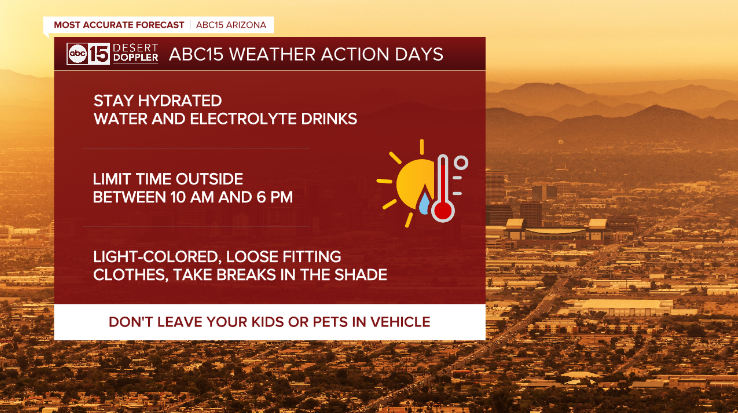The Reasons Behind Missing Excessive Heat Warnings In Forecasts

Table of Contents
Limitations of Current Forecasting Models
Accurately predicting and issuing timely Excessive Heat Warnings is a complex undertaking. While overall temperature trends are relatively predictable, the nuances of localized extreme heat pose significant challenges.
Difficulty Predicting Localized Extreme Heat
While we can often predict general temperature increases, pinpointing hyperlocal heat pockets requires a level of precision that current models sometimes struggle to achieve.
- Complex interactions: Topography plays a significant role. Mountains create rain shadows, leading to intensified heating in some areas. Urban heat islands, caused by dense building concentrations and infrastructure, can dramatically elevate temperatures in cities compared to surrounding rural areas. Microclimates, influenced by factors like vegetation and water bodies, further complicate accurate prediction.
- Resolution limitations: Weather models have a limited spatial resolution. They operate on gridded data, and the size of these grids can mask highly localized temperature spikes. Smaller, more precise grids require significantly more computing power and data.
- Insufficient data: The density of weather stations, particularly in rural areas, is often insufficient to capture the full spectrum of temperature variations across a region. This lack of localized data hinders the accuracy of hyperlocal heat predictions.
Uncertainties in Weather Pattern Prediction
Predicting the evolution of weather systems, especially those leading to heat waves, is inherently challenging. The chaotic nature of atmospheric dynamics makes long-range forecasting inherently uncertain.
- The butterfly effect: Small initial changes in atmospheric conditions can have disproportionately large effects down the line. This makes precise prediction of heat wave trajectories and intensity extremely difficult, especially several days or weeks in advance.
- Long-range prediction limitations: While progress has been made, long-range forecasting models still have limitations. Inaccuracies in predicting atmospheric circulation patterns directly impact the accuracy of heat wave predictions.
- Unexpected changes: Unexpected shifts in atmospheric conditions, such as sudden changes in wind patterns or the arrival of a weather front, can significantly alter a heat wave's intensity and duration, rendering initial predictions inaccurate.
Data Gaps and Infrastructure Challenges
The lack of comprehensive and reliable data significantly hinders the ability to issue accurate and timely Excessive Heat Warnings. This includes both ground-level monitoring and the effective integration of diverse data sources.
Lack of Sufficient Ground-Level Monitoring
Many regions lack a sufficiently dense network of weather stations capable of providing the high-resolution data needed for precise heat wave forecasting.
- Uneven distribution: Weather stations are often clustered in urban areas, leaving rural regions with sparse data coverage. This results in significant gaps in our understanding of regional temperature extremes.
- Aging equipment: Many existing weather stations use aging or malfunctioning equipment, leading to inaccurate or incomplete data. Regular maintenance and upgrades are crucial.
- Maintenance difficulties: Maintaining and upgrading a widespread network of weather stations is costly and logistically challenging, particularly in remote or difficult-to-access locations.
Data Assimilation and Integration Challenges
Effectively combining data from various sources – satellites, weather stations, ground-based sensors – is crucial for improving model accuracy. However, this process presents significant challenges.
- Real-time integration: Integrating diverse data sources in real time is computationally intensive. Delays in data processing can result in late or inaccurate predictions.
- Computational limitations: Processing and analyzing vast amounts of data from diverse sources requires significant computational resources, which can be a constraint for some meteorological agencies.
- Advanced algorithms: Developing advanced algorithms and utilizing AI-powered solutions are crucial for efficiently processing and analyzing complex datasets and improving forecasting accuracy.
Communication and Dissemination Barriers
Even with accurate predictions, effective communication of Excessive Heat Warnings is paramount to ensure public safety. This requires targeted strategies and proactive public education.
Effective Communication Strategies
Clear, concise, and accessible warnings must reach all segments of the population, especially those most vulnerable to heat-related illness.
- Language and culture: Warnings need to be tailored to account for language barriers and cultural sensitivities. Simple, easily understood language is vital.
- Multi-channel dissemination: Using multiple communication channels, including TV, radio, social media, mobile apps, and community outreach programs, maximizes the reach of warnings.
- Targeted outreach: Vulnerable groups, such as the elderly, people with pre-existing health conditions, and low-income communities, need targeted outreach and support to ensure they receive and understand the warnings.
Public Awareness and Preparedness
Public education plays a critical role in fostering understanding and proactive measures to mitigate heat-related risks.
- Heat illness awareness: Raising awareness about heatstroke, heat exhaustion, and other heat-related illnesses is crucial, along with information on prevention and treatment.
- Proactive measures: Educating the public on proactive measures, such as staying hydrated, seeking shade, and limiting strenuous outdoor activities during heat waves, is essential.
- Community plans: Developing community-based preparedness plans, including cooling centers and emergency response protocols, ensures community resilience during extreme heat events.
Conclusion
The absence of timely and accurate Excessive Heat Warnings stems from a complex interplay of technological limitations, data gaps, and communication challenges. Improving forecasting models through increased investment in weather monitoring infrastructure, better data assimilation techniques, and the utilization of advanced algorithms is crucial. Simultaneously, optimizing warning dissemination strategies and boosting public awareness and preparedness are vital steps to ensure public safety during periods of extreme heat. We need to invest in research, technology, and public education to better predict and respond to these increasingly frequent and intense heat waves. Let’s work towards a future with more reliable and effective excessive heat warnings, heat wave preparedness plans, and improved heat wave forecasts to protect vulnerable communities and reduce heat-related risks.

Featured Posts
-
 Plires Programma Tileorasis Gia Tin Kyriaki 16 3
May 30, 2025
Plires Programma Tileorasis Gia Tin Kyriaki 16 3
May 30, 2025 -
 Cannes Film Festival 2024 Guillermo Del Toros Sangre Del Toro Documentary
May 30, 2025
Cannes Film Festival 2024 Guillermo Del Toros Sangre Del Toro Documentary
May 30, 2025 -
 Tileoptikes Metadoseis M Savvatoy 19 Aprilioy Odigos Programmatos
May 30, 2025
Tileoptikes Metadoseis M Savvatoy 19 Aprilioy Odigos Programmatos
May 30, 2025 -
 Sagging Housing Market Are Home Sales In A Crisis
May 30, 2025
Sagging Housing Market Are Home Sales In A Crisis
May 30, 2025 -
 Open Ais 2024 Event Easier Voice Assistant Creation Than Ever Before
May 30, 2025
Open Ais 2024 Event Easier Voice Assistant Creation Than Ever Before
May 30, 2025
